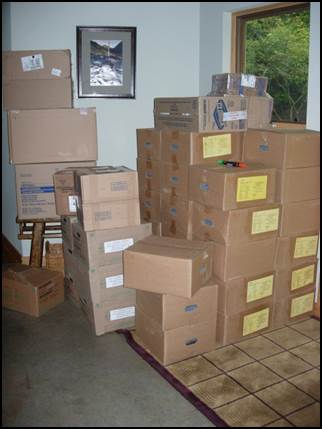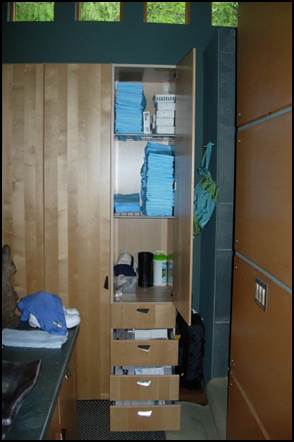By Linda Gromko, MD and Jane C. McClure, Interior Designer
When Linda and her husband, Steve Williams, brought Steve’s dialysis machine home, they felt reasonably confident about the mechanics of home dialysis. But the next day – when sixteen cubic feet of dialysis supplies arrived, they felt overwhelmed! After all, who has even one extra storage closet just waiting to be used? How could they incorporate all this “stuff” into their already busy household? Sound familiar?
(Now, it’s true that the newer procedure of preparing dialysate from tap water and storing a couple of batches under the machine will minimize the sheer quantity of supplies. But storage will always be an issue – whether you’re doing hemo or peritoneal dialysis at home.)
Why is storage such a big deal anyway?
First of all, the presence of medical supplies changes the “feel” of a home. If you are surrounded by medical supplies, it can feel like you live in an ICU. Supplies scream out, “This is a sick room!” It’s harder to feel normal. You may find that friends or family are uneasy about medical equipment – at exactly the time when we need all the support we can get.
Additionally, medical supplies add clutter. And clutter makes us feel disorganized and even more “out of control!”
With a plan for storage, we reclaim our homes as the respites they should be – places of comfort for everyone living there!
Where to start?
If possible, plan your space so you can have the supplies for 3 to 5 treatments right in your dialysis space. The rest can go in a more distant storage area – a basement or garage, for example.
1. Look for storage equipment around your home or apartment as you make your plans. An old TV armoire or entertainment center can be very useful. While obsolete with flat screen TVs, they offer enormous storage space – and have doors to keep supplies out of sight. Dressers can house smaller supplies in drawers, again looking “non-medical.” Jane points out that damaged pieces can be spray painted a solid black or solid white to blend in with other furnishings. If an armoire or dresser would work for you, but you don’t happen to have one, check your local Goodwill or other thrift shop.
2. Dialysate bags for hemo or peritoneal dialysis require some special attention. Here are some tips to help:
· Removing the bags from their cardboard boxes ahead of time will save you precious moments.
· While it’s not recommended that you stack the bags, you can nestle them together side-by-side for the most efficient use of space.
· Storage shelves should be smooth and easily cleaned. Melamine works well, but stay away from wire shelving.
· Be sure to recycle what you can – as part of your routine.
3. Cartridges, Tubing, and Saline will be delivered in a batch once a month.
· These supplies store easily in shelving units, armoires, or dressers.
· Keeping them organized will simplify your inventory.
4. Keep shelving units safe!
· Load heavy items onto the lower shelves, and lighter items (like Chux underpads) overhead to reduce the risk of tipping.
· Anchor your shelving units to the wall to earthquake-proof your space.
· Provide a step stool to discourage shelf-climbing!
5. Create individual supply packets – or “Daily Packs.”
· Use gallon sized zip-lock style bags to hold all of the small items for a single day’s dialysis run. Each pack includes the required number of syringes, four-by-four gauze pads, catheter caps, alcohol wipes, etc. Making these a week ahead can save hours of your time.
· Make “Weekly Packs” that hold items that are re-used through the week, such as your Heparin vial and syringes for hemodialysis, and paper and plastic tape.
· These packs greatly simplify traveling also!
6. Baskets work for storage and décor!
· Baskets are useful, attractive, and inexpensive – and they come in a variety of sizes. They are highly functional – and they add texture and warmth to your room. Look for these at import stores and thrift shops.
· Use a tall wicker hamper with a hinged lid to house Chux, cleaning wipes, and paper towels.
· Line a large lidded wicker basket with a plastic garbage bag to simplify your trash management. Store extra garbage bags on the floor of the basket to save you steps later on.
· Jane hung a beautiful rattan tote bag on Steve’s wall to hold an entire month’s supply of fistula needles.
Dialysis can enter your lives suddenly, and can seem to take over your world. But with some foresight and planning, you can get yourself back in control of the process. We hope these tips will help you simplify the process of doing your own home dialysis. It’s well worth the effort to get the best dialysis available – and to retain as much freedom as you can!
Linda Gromko MD is a Seattle family physician who assisted her late husband with home dialysis – both hemo and peritoneal – for over three years. Jane McClure is a Seattle Interior Designer. Read more in their book, “Arranging Your Life When Dialysis Comes Home: ‘The Underwear Factor,’” available on Amazon.com.





